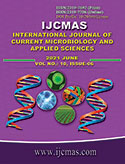


 National Academy of Agricultural Sciences (NAAS)
National Academy of Agricultural Sciences (NAAS)

|
PRINT ISSN : 2319-7692
Online ISSN : 2319-7706 Issues : 12 per year Publisher : Excellent Publishers Email : editorijcmas@gmail.com / submit@ijcmas.com Editor-in-chief: Dr.M.Prakash Index Copernicus ICV 2018: 95.39 NAAS RATING 2020: 5.38 |
Bacterial wilt of brinjal caused by Ralstonia solanacearum is endemic in most brinjal growing areas of Chhattisgarh state causing 40 to 80% loss in yield. Control measure requires definite information on race and biovar characteristics of the pathogen in those endemic areas. Five Ralstonia solanacearum isolates (Rs 3, Rs 7, Rs 8, Rs 11 and Rs 12,) of brinjal host were tested on different host plants which are host pathogenic. Under pathogenicity tests of all five Rs isolates on different host ranges, the brinjal, tomato, chili, potato, geranium, cucurbits and cucumber plants were infected and showed wilted symptoms except Rs 11 in geranium. While ginger, banana, rose, soybean and sweet potato plants were not infected with any Rs isolates and remained healthy. According to the described in EPPO, 2004, the pattern of the infection caused by different Rs isolates on different host range were studied and found that the dominant Rs isolates in Chhattisgarh state was grouped under Race 1 (caused wide variety: Ginger, olive, chili pepper, peanut, Solanum spp., tobacco, Musa spp. (banana and plantain), peanut, Heliconia tomato and distributed in Asia, Africa, Australia, north and south America) followed by Race 3 and Race 2 with 53.84%, 38.46% and 7.69%, respectively. Therefore, dominant groups of Rs isolates causing bacterial wilt of brinjal belonged to race 1 and biovar III.
 |
 |
 |
 |
 |